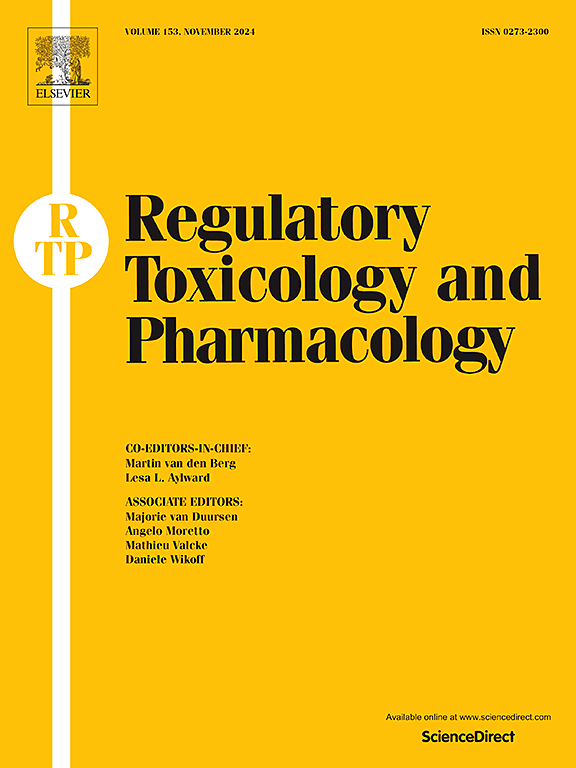Establishment of a threshold of toxicological concern for pharmaceutical intermediates based on historical repeat-dose data and its application in setting health based exposure limits
IF 3
4区 医学
Q1 MEDICINE, LEGAL
引用次数: 0
Abstract
Availability of toxicological data for pharmaceutical intermediates (IMs) used in the manufacture of small molecules is often limited. Scarcity of data – in particular, repeat-dose toxicity (RDT) – renders the calculation of health-based exposure limits (HBELs) problematic. Establishment of HBELs, including occupational exposure limits (OELs) and permitted daily exposures (PDEs) facilitating worker and patient safety respectively, is however essential. Historic 28-day oral rodent toxicity data was analysed for 103 GSK isolated IMs. No-observed (adverse) effect levels (NO(A)ELs) and critical effects were extracted. The 5th percentile (p05) of the NO(A)EL distribution was 15 mg/kg/day. Substance specific HBELs were calculated, selecting the NO(A)EL as the Point of Departure (PoD); 99% of IMs (n = 102) were assigned an oral PDE ≥1000 μg/day and OEL ≥100 μg/m3. A default oral PDE of 1000 μg/day and OEL of 100 μg/m3 is thus proposed for IMs. Evaluation of an additional PoD – benchmark dose lower confidence limit (BMDL) – further supported the default HBELs. The default oral PDE can also serve as a threshold of toxicological concern (TTC) for IMs. Default limits can aid in setting HBELs for novel data-poor IMs, as well as supporting waiving of RDT in the future through read-across.

基于历史重复剂量数据的药物中间体毒理学关注阈值的建立及其在设定健康暴露限值中的应用。
用于制造小分子的药物中间体(IMs)的毒理学数据通常是有限的。数据的缺乏——特别是重复剂量毒性(RDT)——使得基于健康的暴露限值(hbel)的计算存在问题。然而,建立hbel,包括职业暴露限值(oel)和允许的每日暴露(PDEs),分别促进工人和患者的安全是至关重要的。对103例GSK分离的IMs进行28天口服啮齿动物毒性数据分析。提取未观察到的(不良)效应水平(NO(A) el)和临界效应。NO(A)EL分布的第5百分位(p0.05)为15 mg/kg/d。计算物质特异性hbel,选择NO(A)EL作为出发点(PoD);99%的IMs (n = 102)口服PDE≥1000 μg/d, OEL≥100 μg/m3。因此,建议IMs的默认口服PDE为1000 μg/d, OEL为100 μg/m3。额外PoD的评估——基准剂量下限(BMDL)——进一步支持了默认的hbel。默认的口服PDE也可以作为IMs毒理学关注(TTC)的阈值。默认限制可以帮助为新的数据贫乏的im设置hbel,并支持将来通过读透免除RDT。
本文章由计算机程序翻译,如有差异,请以英文原文为准。
求助全文
约1分钟内获得全文
求助全文
来源期刊
CiteScore
6.70
自引率
8.80%
发文量
147
审稿时长
58 days
期刊介绍:
Regulatory Toxicology and Pharmacology publishes peer reviewed articles that involve the generation, evaluation, and interpretation of experimental animal and human data that are of direct importance and relevance for regulatory authorities with respect to toxicological and pharmacological regulations in society. All peer-reviewed articles that are published should be devoted to improve the protection of human health and environment. Reviews and discussions are welcomed that address legal and/or regulatory decisions with respect to risk assessment and management of toxicological and pharmacological compounds on a scientific basis. It addresses an international readership of scientists, risk assessors and managers, and other professionals active in the field of human and environmental health.
Types of peer-reviewed articles published:
-Original research articles of relevance for regulatory aspects covering aspects including, but not limited to:
1.Factors influencing human sensitivity
2.Exposure science related to risk assessment
3.Alternative toxicological test methods
4.Frameworks for evaluation and integration of data in regulatory evaluations
5.Harmonization across regulatory agencies
6.Read-across methods and evaluations
-Contemporary Reviews on policy related Research issues
-Letters to the Editor
-Guest Editorials (by Invitation)

 求助内容:
求助内容: 应助结果提醒方式:
应助结果提醒方式:


